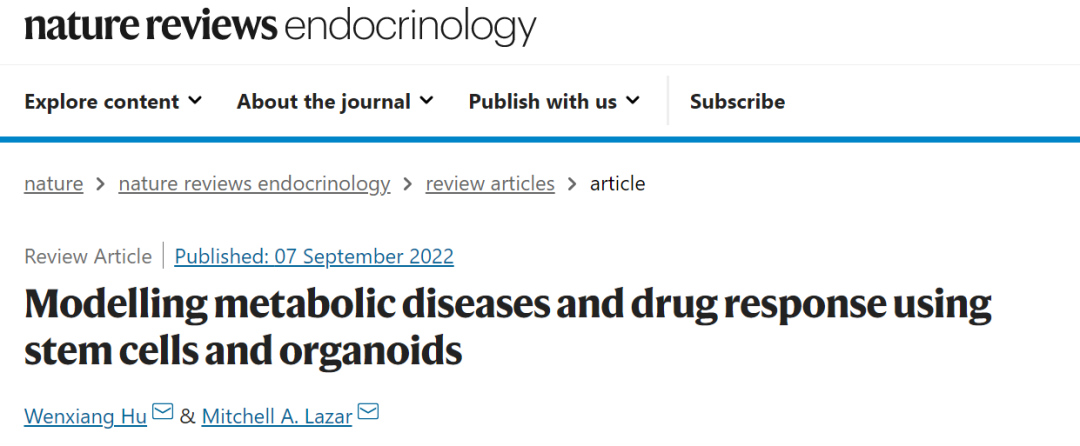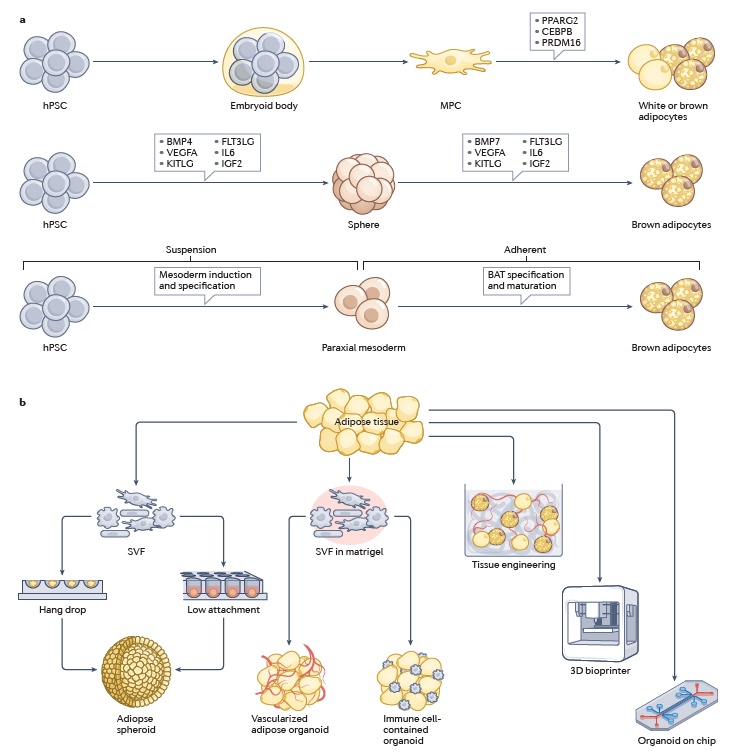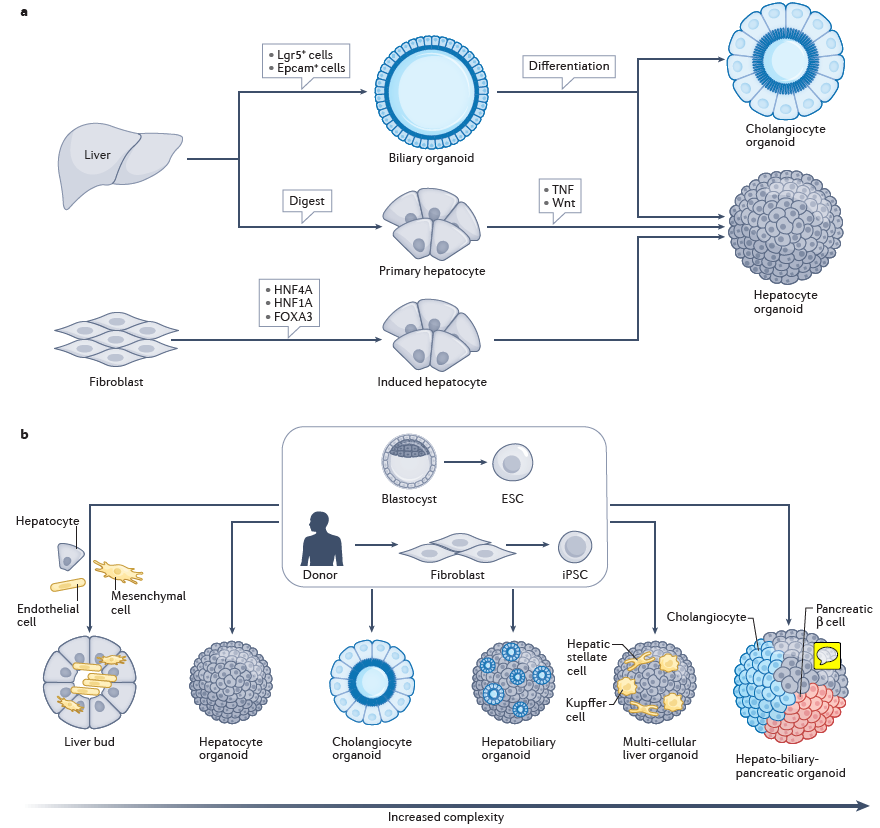Relators | Stem cells and organ simulation of metabolic diseases and drug reactions
Author:Bioart biological art Time:2022.09.12

#类 类#
Metabolic diseases, including obesity, diabetes, and cardiovascular diseases, are the main threats to human health in the modern world, but the lack of appropriate human models restrict the research and development of the mechanism of metabolic diseases. It is worth noting that the advancement of stem cells and organ technology allows stem cells and organ models that can engrav the human organ tissue form, molecules and physiological characteristics. Combined with gene editing tools, the booming development of human stem cells and organ models provides an unprecedented good system for the study of metabolic diseases.
On September 7, 2022, a researcher Hu Wenxiang from the Guangzhou Lab and Professor Mitch Lazar from the University of Pennsylvania published on Nature Reviews Endocrinology, entitled Modelling Metabolic Diseases and Drug Response USING STEM CELLS and ORGANODSS. The author reviewed the application of stem cells and organ models in the study of metabolic diseases, especially obesity and liver disease in the past ten years. Review of the limitations of animal models, as well as the strong advantages of stem cells and organ models in the research of metabolic disease mechanisms, pharmaceutical discovery, drug toxic side effects and precision medical care. Finally, the author emphasizes the potential of organizing organs and gene editing, which may have a revolutionary impact on the recycled treatment plan for metabolic diseases.

1. The development of fat organs model
Fattic cells (HPSCS) sources of fat cells provide a unique model for studying obesity and diabetes, and solve the problem that it cannot be answered by animal models. Earlier research has established a variety of effective treatments to induces HPSCS to differentiate into white fat cells and brown fat cells. For example, through specific transcription factors, such as nucleus peroxidase proliferation activation receptors (PPARγ) can efficiently induce white fat cells; add additional transcription factor CEBPB and PRDM16, which can promote the differentiated MSCS of HPSC sources to brown into brown. Fat cells. In addition, based on the sources of fat cells, it is reported that the hematopoietic factors can effectively induce the production of brown fat cells; and induces HPSCS to differentiate into the axial germ (Paraxial Mesoderm), which perfectly simulates the in vitro differentiation process of brown fat cells.
Considering that adipose tissue is a highly heterogeneous organs, understanding the interaction between various cells-cells in fat tissues is essential for clarifying the mechanism of fat development, activation or dysfunction. point. As a result, some research teams have developed the induction scheme of various fat organs. Such as the fat tissue matrix vascular composition (SVF) grow into spherical body in suspension plates, low adsorption plates, or SVF cells and other cell types are cultivated in matrix glue, forming vascularized fat organs or immune cells containing immune cells Fat organs. In addition, organizational engineering, biological printing, and organ chip technology can help create more complex and mature fat organs, and help the study of fat development, diseases and other organs (Figure 1).

Figure 1. The development of fat cell models and fat organs from the source of polysone stem cells
Second, the development of liver organs model
Since the first intestinal organs established by LGR5+stem cells, similar methods have been applied to produce organs from other tissue stem cells. For example, the solution for generating liver organs from LGR5+cells is: Together with LGR5+stem cells and WNT excitement R-SPONDIN, the cyst-like structure can be cultivated in the matrix glue. These cyst-like structures can be further differentiated into functional liver cells and transplanted. You can survive and proliferate when you go to FAH-/-M rat. In addition, EPCAM+bile duct cells in the liver tissue can also form liver liver organs, and keep genome stability in long -term amplification. Recent studies have found that the end -differentiated liver substantial cells can efficiently form hepatocyte organs under the training conditions such as WNT signal activation and inflammatory signal stimulation. In addition, the research group of Teacher Huili Jian in the Shanghai Biochemical Cell Research Institute can also directly generate liver cells from forming fibroblasts.
In addition to adult stem cells, inducing polyo -stem cells (IPSCS) has the ability to generate liver organs that have patient specificity and stable liver organs, and can be widely used to simulate liver disease and precision medical care. Figure 2 summarizes a variety of liver organs models under different culture conditions. These models include liver buds, hepatocyte organs, bile duct cell organs, hepatobiliary organs, multi-cell liver organs and liver-bile-pancreas, and their structure and functional complexity gradually develop.

Figure 2. The development of liver organs model
Third, the application of organs in the research of metabolic disease mechanisms and drug precision medical care
Organs simulate various organizations in structure and functions. This technology has opened up new opportunities for analyzing the potential mechanism of metabolic diseases and developing personalized drugs. Liver organs can be used to simulate multiple liver diseases, such as hereditary liver disease, non-alcoholic fatty liver (Nafld) and virus-host interaction. Fat organs provide a good platform for studying obesity, lipid metabolism, and insulin reactions. In addition, the establishment of a large -scale organs can be used as a biological sample library that guides precision medical care. The organ can also be used to screen and predict the toxicity of high -throughput drugs. The author emphasizes that his own research group uses the patient's stem cells and organ models to predict the important discovery of the individual response of the Cell STEM Cell (2019) and the corticoid drugs (2021) (2021) (Figure 3) Essence Figure 3: The application of organ research and drug precision medical treatment in metabolic disease mechanisms and drug precision medical treatment

Fourth, regeneration medicine for metabolic diseases
Use CRISPR/CAS9 or other gene editing tools to change genetic mutations related to diseases in organs, and transplant the genetic organs from the body into an individual of metabolic diseases, which can ensure that the transplanting plant can be more immune to react. A good survival; in addition, you can use gene editing to develop the cells or organs of HIPSC sources that have been matched with HLA. The brown fat cells from the transplanted IPSCS source can treat metabolic diseases such as obesity by increasing energy consumption.
Figure 4. Regeneration medicine for metabolic diseases

5. Summary and outlook
The lack of accurate and reliable in vitro models to reflect human physiology, which has greatly restricted the transformation of metabolic diseases. Whether it comes from the hepatocytes and fatigue organs that originated from the apex stem cells, health tissues, or lesion tissues, they have shown huge potential in studying the development and treatment of human metabolic diseases. However, the current organ technology technology is not perfect, and it is necessary to combine advanced technologies and theories such as organizational engineering technology to improve the efficiency, quantity and quality of organs, as well as the complexity and maturity of organs. We expect the sustainable development of organ technology to further meet the gap between basic research and transformation of medical diseases.
Hu Wenxiang's research team is committed to the application of stem cells, mice models, functional genome, gene editing and raw faith analysis. The research team has sufficient research funding. Due to the research needs of the subject, the associate researchers and post -doctoral posts are now publicly recruited. I look forward to the youth talent joining! For laboratory information, please refer to: https://www.x-mol.com/groups/hu_wenxiang
Original link:
https://www.nature.com/articleS/S41574-022-00733-z
Want to know more exciting content, come and pay attention to BIOART biological art


- END -
Ancient Shu Yibei, Four Famous Sailing, Best King ... "Passionate 'Belle' -The Wonderful shellfish World" Special Exhibition July 20

It has been with dinosaurs to witness the earth's vicissitudes of the sea for 500 ...
Daqing City Section 4 Taijiquan Championships starts in Datong District
